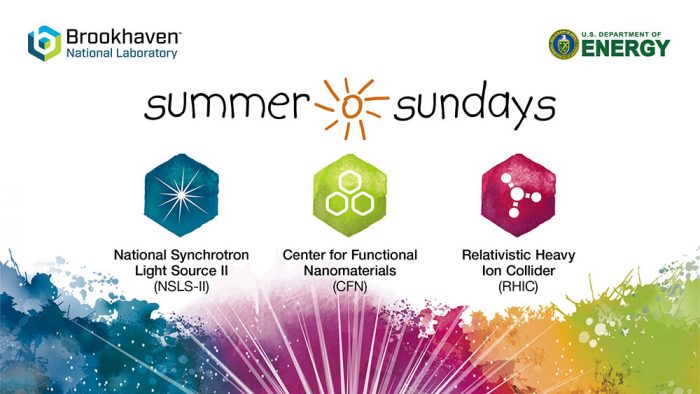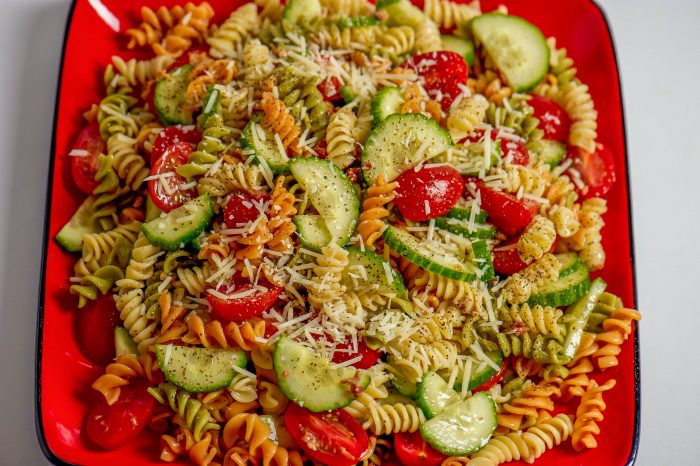By Barbara Beltrami
Summer pastas take advantage of the season’s bounty and feature veggies and herbs and other warm weather flavors that go hand in hand with the outdoors where the livin’ is easy. They’re light, they’re colorful and they’re savory. And like the livin’, they’re easy to put together. My favorite is a pasta with lemon and herbs. Of course, there’s pasta with pesto which is wonderful on its own and even more wonderful with the addition of finely diced summer veggies. And if spring and summer take you fishing, boating or beaching and you get a hankering for seafood, there’s pasta with crabmeat and peas.
Farfalle with Lemon and Herbs
YIELD: Makes 4 to 6 servings
INGREDIENTS:
1 pound farfalle pasta
2 tablespoons olive oil
2 tablespoons unsalted butter
1 garlic clove, bruised
1/2 cup chopped fresh basil leaves
1/2 cup chopped fresh flat leaf parsley leaves
1/4 cup snipped fresh garlic chives
1 tablespoon (T) fresh lemon thyme leaves
1 T chopped fresh lemon verbena leaves
1 T chopped fresh lemon balm leaves
1 T finely grated lemon zest
2 T freshly squeezed lemon juice
Salt and freshly ground white pepper to taste
1/2 to 2/3 cup pasta water
DIRECTIONS:
Cook pasta according to package directions. Meanwhile, in a large deep skillet heat olive oil and butter over medium heat; add garlic clove and cook one or two minutes until it releases its aroma; remove and discard. Add basil, parsley, chives, thyme, verbena, lemon balm, zest, and juice, salt and pepper; cook, stirring frequently, over medium heat. When pasta is just al dente, drain and add to skillet with the half to two-thirds cup pasta water; over medium-low heat, toss to coat thoroughly. Serve hot or warm with fresh sliced tomatoes and mozzarella.
Fusilli with Basil Pesto and Confetti Veggies
YIELD: Makes 4 to 6 servings
INGREDIENTS:
1 pound fusilli
8 to 10 large sprigs of basil, leaves removed
1/2 cup freshly grated parmigiano cheese
1/2 cup pignoli nuts
1 large garlic clove
1 cup extra virgin olive oil
Salt and freshly ground black pepper to taste
1/4 cup or more pasta water, if needed
1 small zucchini, cut into half-inch dice
1 medium potato, peeled and cut into half-inch dice
1 medium tomato, seeds removed, cut into half-inch dice
DIRECTIONS:
Cook fusilli according to package directions. Meanwhile place basil, cheese, nuts, garlic, 3/4 cup of the oil, salt and pepper in bowl of electric food processor. Puree mixture, scraping bowl often, until it is smooth and turns a light green color; if it seems too thick, add pasta water a tablespoonful at a time until right consistency is achieved; set aside. In large skillet heat remaining oil over medium-high heat; add zucchini, potato and tomato and saute, stirring frequently until tender, about 5 minutes. In large pasta bowl, toss pesto and pasta together, sprinkle with sautéed veggies and serve hot, warm or at room temperature with a crusty bread.
Capellini with Crabmeat and Peas
YIELD: Makes 4 to 6 servings
INGREDIENTS:
1 pound capellini (very thin spaghetti)
1 pound fresh or frozen shelled peas
8 ounces unsalted butter
1 tablespoon chopped fresh tarragon leaves
1/4 cup fresh snipped chives
1/3 cup freshly grated parmigiano cheese
Salt and freshly ground white pepper to taste
1 pound lump crabmeat, picked over
DIRECTIONS:
Cook pasta according to package directions but 3 minutes before end of cooking time add peas to pasta water and continue to cook until it is al dente. Meanwhile, in a very large skillet over moderate heat, melt butter; add herbs. Add pasta and peas, grated cheese, half a cup (more if needed) of pasta water, salt and pepper to skillet. Tossing constantly, continue cooking the mixture over low heat until pasta is coated with a light creamy sauce, about 3 to 4 minutes. Add crabmeat and cook over medium-low heat, just enough to heat through, about a minute or two. Serve hot or warm with an arugula salad and crisp dry white wine.


















